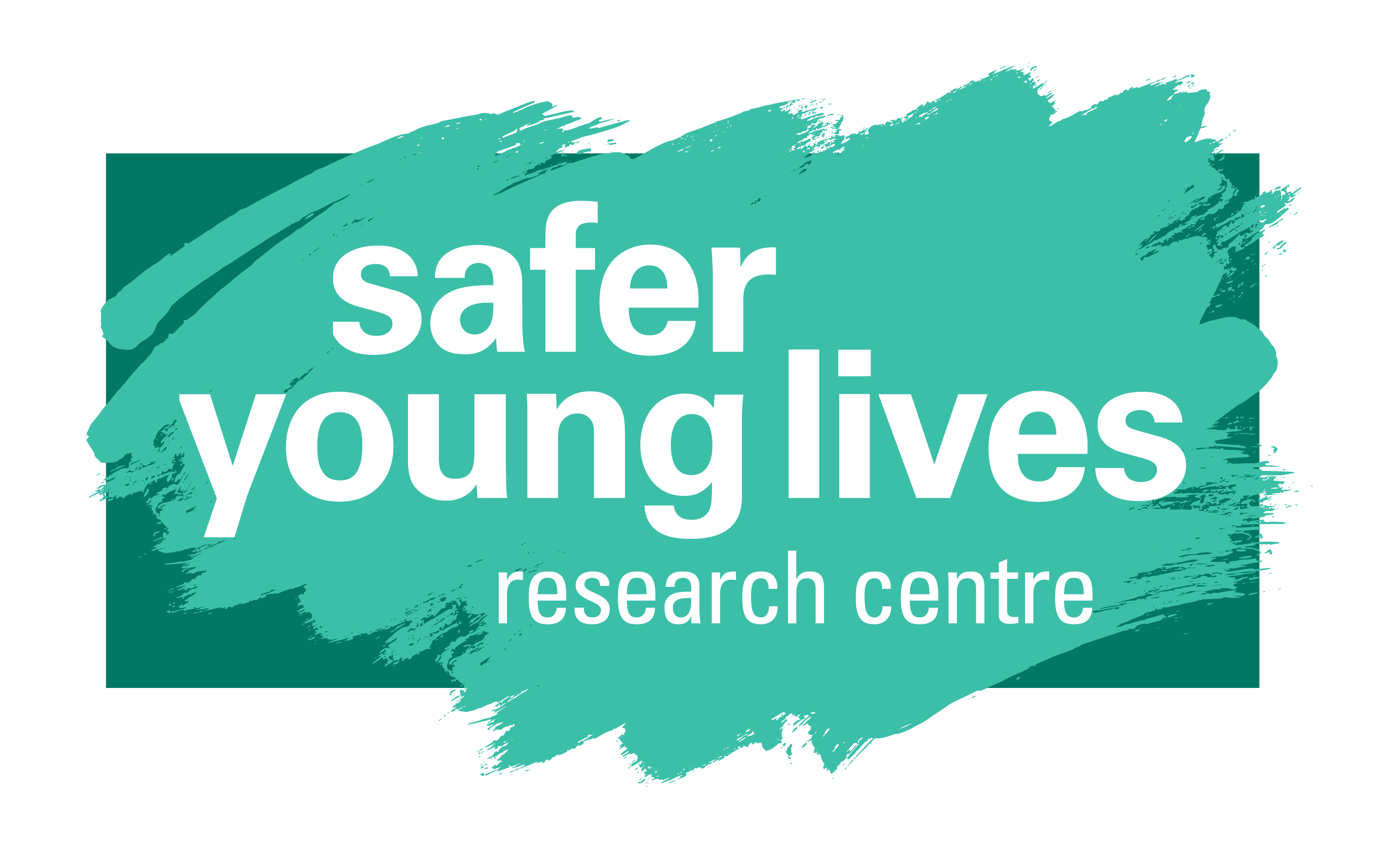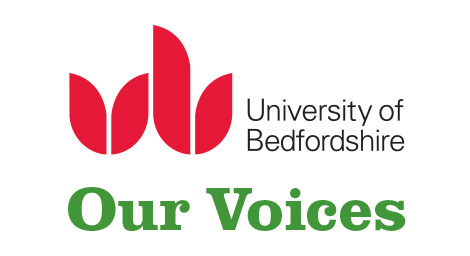Conveying complexities through comics
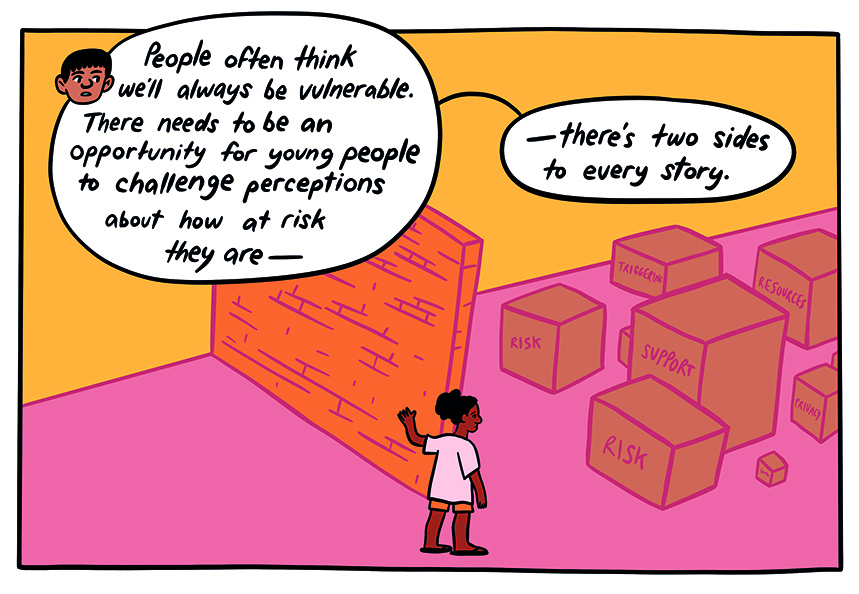
Identifying the most appropriate and engaging ways to share research findings with different groups of stakeholders can be challenging - especially when conveying complex messages. A journal article or research report may be inaccessible to many, whilst a one-page summary may risk oversimplifying findings or overlooking important nuances. To address this, we decided to try a new approach to communicating some of our recent research findings.
This blog explains the process of working with an illustrator to develop a comic to convey some of the key themes and intricacies of our findings. It also shares some of the feedback we received from young research participants who had been involved in the research and how we incorporated this into the final version of the comic.
Background to the research
The participation of children and young people in decisions that affect them and their communities is enshrined in the United Nations Convention on the Rights of the Child (1989). However, we know that not all children and young people are afforded their rights to inform and influence decisions about their own care, or to engage in opportunities for ‘collective participation’ – taking part in activities to influence actions that may affect others. Children and young people who have experienced child sexual abuse and exploitation are one such group. Yet, emerging evidence indicates that their involvement can bring myriad potential benefits, not only for the young people themselves, but also for organisations and wider society (Cody et al., forthcoming). In order to explore this in more detail, in 2022 we undertook a research study to find out from those with experience and knowledge in this area what they felt the potential outcomes of participation might be in this context.
The first phase of this research aimed to measure consensus about participation outcomes among a panel of 58 experts. Our panel was comprised of adult professionals - including academics, practitioners, activists and adult survivors working in the field - together with young survivors who had experience of engaging in participatory initiatives to address child sexual abuse and exploitation. Panel members were based in 18 different countries. All completed an online questionnaire where they were asked to rate 97 statements about the participation of children and young people with direct experience of child sexual abuse and exploitation. The questionnaire also allowed participants to add additional comments about each statement if they wished.
Following this first phase, we ran a series of focus groups with adult panel members to explore some of the questionnaire areas where there was less consensus, and to discuss themes arising in the commentary on the statements. It was clear from the ratings in the first round questionnaire that whilst overall there was strong consensus on the potential positive outcomes associated with the participation of children and young people, the supplementary qualitative data provided highlighted layers of associated complexity. Even where panel members agreed on ratings, they often held different views, experiences and perspectives. We therefore wanted to create an output to share some of these viewpoints and tensions, particularly with practitioners and young people, so that they could understand each other’s different opinions, ideas and concerns.
Developing the comic
We identified four key themes from the data that we felt would work well in a comic as they attracted a range of views and experience-based reflections.
The themes were:
- readiness and risk assessments
- triggering
- feelings of anger and frustration and;
- public identity disclosure.
We drafted a script for each of the four themes, drawing directly from the commentary in the questionnaire and focus group discussions. We then commissioned Maria Stoian, a comic artist and illustrator, to help bring our ideas to life.
The process for gaining inputs
As the purpose of the comic was to allow young people and practitioners to think about and understand different perspectives, experiences and concerns, we were keen to ensure that the young people who had engaged in the research had the opportunity to input into the comic when it was still in draft form.
We contacted our original partner organisations who had supported the engagement of young people in the research to see if they had the capacity to support young people to participate in the comic project. We were then able to work with three of our partner organisations and engage six young panel members from the study (plus an additional two young people who had not taken part in the study). This included one young woman in Albania, two young men from Uganda and five young women in Serbia (three of whom took part in the original research).
Additional feedback on the comic was also sought from the practitioners who facilitated the comic feedback sessions with young people and three current/former members of our Young Researchers’ Advisory Panel (YRAP) at the Safer Young Lives Research Centre.
We developed a two-hour workshop plan to help facilitators introduce the project to the young people and to ensure they understood, and were happy to engage in the process. The workshop plan provided ideas for questions and activities to allow for reflection and sharing.
Along with the workshop plan, we shared the draft comic script and various styles of sample ‘scenes’ that Maria had developed to enable reviewers to get a sense of how the comic might look. We gave young people the choice of which themes they wanted to review. Some chose to look at all four themes, others focussed on two or three.
Incorporating feedback
We received so much useful feedback from the young people and other reviewers. Below are examples of some of the comments received on different aspects of the comic and how we addressed these in subsequent iterations.
The script: Emphasising the importance of respecting young people and understanding their needs and experiences
Some of the key things that young people commented on in relation to the script were around the importance of promoting an elevated respect among professionals towards young people, and a greater understanding of their individual needs and experiences.
For example, one reviewer felt that rather than the practitioners in the comic using a young person’s pronouns - ‘he, she or they’ - the use of (fictional) first names was important and would make the output more personal and compelling.
What we changed: We changed relevant parts of the script so that when practitioners were talking about young people they referred to them by name.
Feedback also reminded us that whilst in the comic we use the term ‘young survivor’ when referring to young people with lived experience of child sexual abuse and exploitation, not everyone will identify - or be comfortable - with this label
What we changed: In response to this we added a definition and explanation about why we were using that particular term but acknowledging that not everyone identifies with this identity.
The salience of respecting young people and their experiences was also underscored when thinking about ‘triggering’. The draft script included a definition of ‘triggering’ and one young person commented that they were pleased to see this, noting that:
‘I love that triggering is defined, as it seems in recent years, the word has been used in other contexts and used in jokes, so it’s nice that its real meaning was brought to light’.
Expanding on this, another reviewer felt the definition should ‘go further’ to highlight just how extreme and distressing this can be for young people. The group of young women in Serbia also emphasised important points within this theme that they felt needed to be more strongly communicated. Namely, that young people should be made aware that, if they do choose to participate in different activities and are triggered, it is important that they know they can take a break or stop at any time. They also noted that it was critical that young people not only had support during the activities, but that support was available following their engagement.
What we changed: We added additional text to this section of the comic, emphasising these points and adding to the definition.
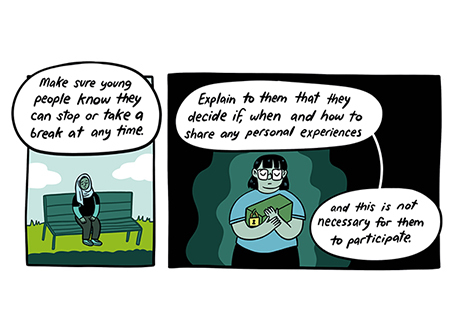
The script: Accuracy of language
Reviewers highlighted where they felt some of the language was problematic. In some cases they recommended replacing words such as ‘catalyst’ and ‘dialogue’ for simpler alternatives. But there were also some more fundamental issues raised.
For example, in the original script we wrote about how young people may be angry when practitioners make ‘decisions on their behalf’. One reviewer challenged us on the accuracy of this phrase and whether decisions are always made on 'behalf of young people' - or if they are made ‘for them’. They went on to explain the difference:
‘For example, my friend might ask if I want anything from Greggs [a bakery chain in the UK] and when they ask what I want, I tell them to "surprise me". They decide to get me a sausage roll as they know I like sausage rolls - they have made that decision on my behalf but with my permission and realistically knowing that I’m likely to appreciate the decision. But if they didn’t bother to ask me and just decided to get me a salad because they think I should have a healthier option - is that really a decision made on my behalf or a decision they have made because of what they think is best?’
What we changed: We felt this was an important distinction to make and so revised this wording for the final version.
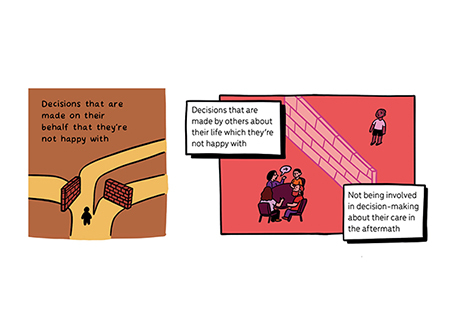
The imagery: Characters
The young people reviewing the comic appeared to be impressed overall with the diversity of the original characters that had been designed in the samples:
‘LOVE the characters, I like that they vary in heights and size overall.’
‘There is a range of diverse backgrounds which is refreshing and inclusive of all young people!’
‘People involved are from different communities, and I liked that the most, because they collaborate for the same cause. And it shows that they are equal.’
However, some still felt that changes could be made to ensure the comic was more representative and inclusive of different identities and contexts. For example, one young person noted the comic could be improved by including a character with an obvious physical disability. Three reviewers also pointed out that young male survivors of child sexual abuse and exploitation needed more prominence in the final comic.
What we changed: A new set of characters was developed for the final version.
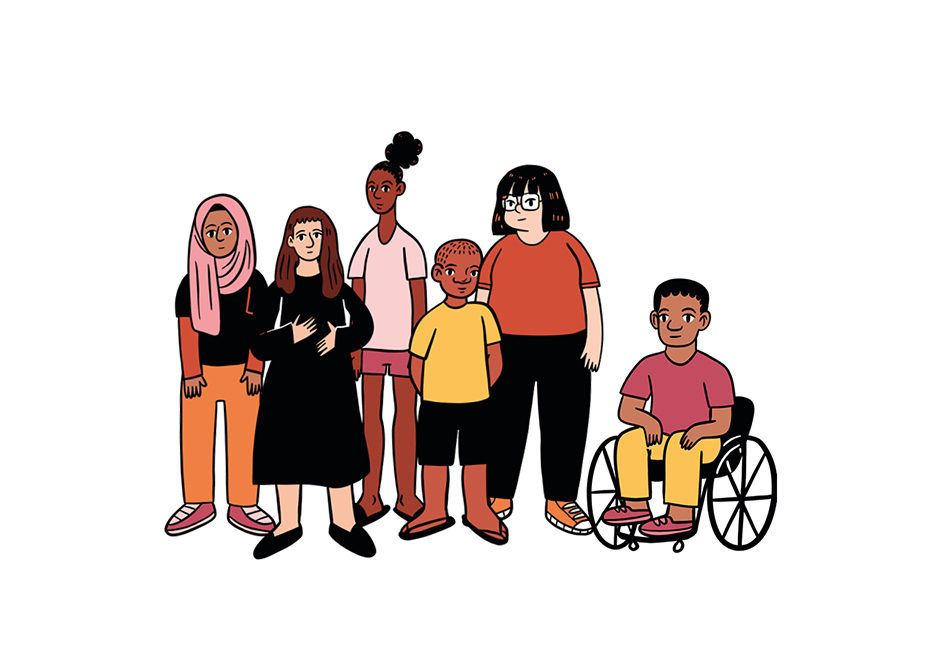
The imagery: ensuring images translate into different contexts
In addition to commenting on the characters, feedback from the young people from Uganda drew attention to the fact that some of the images used in the samples were confusing, unfamiliar or did not translate into their context. They felt that some of the imagery needed to be more relatable or understandable for young people from different contexts.
For example, in one image, a rubber ring was used to convey that a young person was ‘being supported’. One young person commented that to him ‘it looks like someone having fun and doing a swimming activity’.
What we changed: In the next version, a different visual was used (and additional text was added as suggested by young people in Serbia).
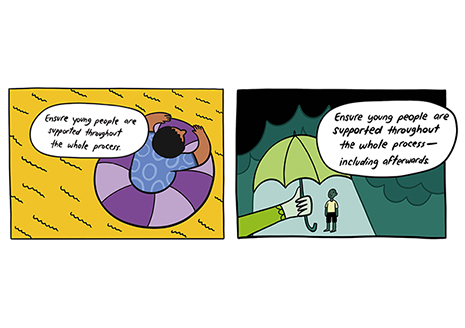
A number of the young people were positive about one image that showed a young person in a corridor facing a series of closed doors. This was used to illustrate how young people can experience anger and confusion when trying to access services and support. However, one young person found this imagery unclear, feeling that it looked like the young person was on a train or looking at closed lockers. They felt the imagery should instead show an example of an actual service in a community setting.
What we changed: In the next version, a different visual was used.
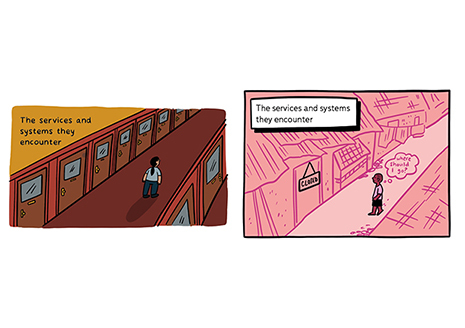
The imagery: Taking the imagery further
One of our reviewers suggested how some of the imagery could go even further to emphasise certain points. For example, in one of the scenes exploring ‘anger’, a young person is seen carrying around a tied up bundle of mess to depict this emotion. Sitting with a group of other young people, she is seen holding onto the anger. In considering this, the reviewer suggested that:
‘It might even be a good idea to show others untangling the mess or otherwise treating it with respect and care rather than running away from or negatively responding to it’.
This worked well in illustrating the data, as within the research a number of panel members noted how sharing emotions with others in a participatory group work setting could be helpful.
What we changed: The images in this scene were updated to reflect this suggestion in the final comic.
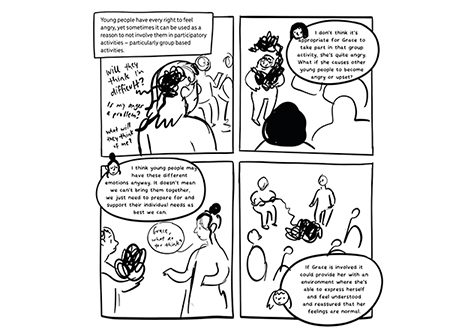
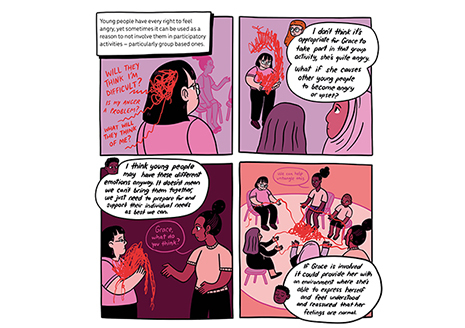
Realism of certain scenes
Finally, young people also commented on whether they felt the scenes in the comic were plausible, relatable and realistic. Most young people shared that they could see these scenes taking place - with some noting a direct resonance with their own experiences.
‘The scenarios are definitely relatable and are easily real enough to actually happen’
Others recognised that although some of the scenes may seem quite problematic, it was important to show how some people may think and express themselves:
‘I think it is good that the characters in the readiness panel are being so blunt, it can seem rude but it is easy to see that it’s just different ways of thinking being shown’
There was however one particular scene where one reviewer questioned whether such a scene would take place in real life:
‘It's difficult to imagine a scene like this - a professional talking with a young person about how it can be "awkward" to have conversations with young people generally about risk … Perhaps [it might work better] if the young person was an experienced and seasoned member of an advisory board that was providing consultancy to a practitioner on their fears of involving other young people?’
What we changed: Based on this reflection and suggestion we were able to add imagery to the scene to clearly show that the young person was an ‘advisor’ rather than a service-user. A notice was added to the door in the scene indicating the young person was attending an ‘advisory group meeting’. This character is also introduced as a ‘youth advisor’ at the start of the comic.
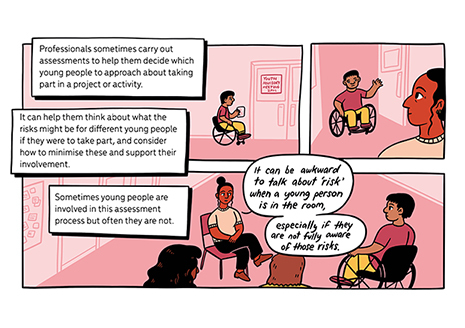
Concluding thoughts
In an ideal world, one with longer timeframes and greater budgets, it would have been really interesting to have been able to work collaboratively with young people to develop the comic from scratch; with them identifying key themes from the research and developing their own ideas for scenes. However, being able to go back to some of the panel members from the research to share with them our interpretation of the findings, and have them feed into the creation of this output also seemed to work well. Using comics to share some of the findings was seen as an engaging and appealing format for the young people (and adults) involved.
‘The very first impression makes you want to read more and more curious about it’
Presenting young people with a draft of something - as opposed to a blank piece of paper - also meant they had something very tangible to work with and critique. Providing different styles, colour palettes and characters enabled them to consider what worked well and what might be missing or improved. There was scope to change different elements of the comic and to emphasise important points that young people felt should be included. Having these insights has no doubt strengthened the final product.
We hope that both other young people and practitioners alike find the comic useful and that it sparks reflection and dialogue. Ultimately, we hope it leads to children and young people with lived experience of child sexual abuse and exploitation having more opportunities to safely and ethically engage in meaningful discussions and decision-making.
We would like to thank all the young people who helped us develop this comic, along with the staff from organisations who kindly supported and facilitated their engagement. Final thanks to Maria, for bringing the script and ideas to life.
Read the full comic 'Seeing Things From Both Sides' here.
You can also download the four comics individually:
- Readiness and risk assessments
- Triggering
- Feelings of anger and frustration
- Public identity disclosure
